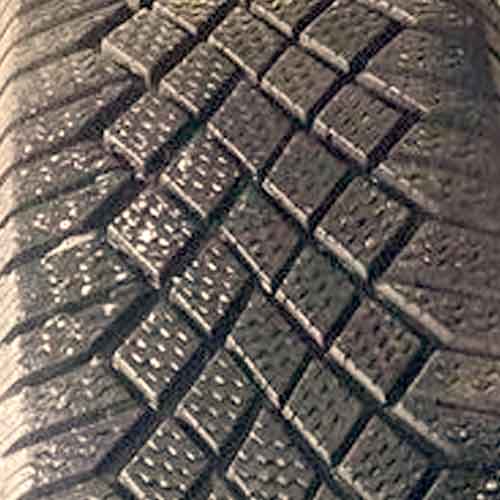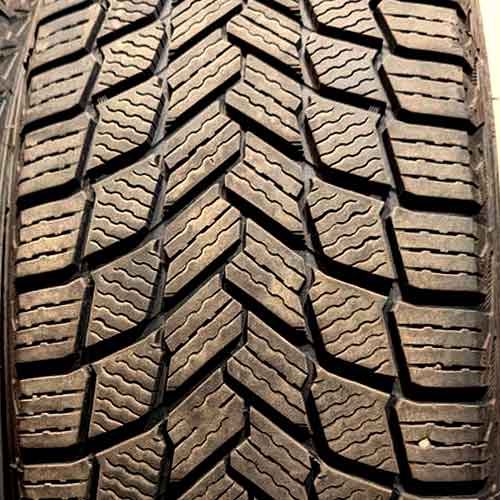Michelin X Ice Snow and Continental VikingContact 7, both being leading names in the world of winter tires, showcase exceptional capabilities in different areas, setting the bar high in grip, durability, and ride quality, thus providing an array of choices to suit varying user preferences and driving conditions.

Table of Contents
Available Sizes
The Michelin X-Ice Snow (review) comes in 125 total sizes in 15 to 22 inches. They have following specs.
- Speed ratings: T and H.
- Load ratings: SL and XL.
- Tread depth: 10.5/32″ on all.
- Weight: 16 to 40 lbs.
- Tread warranty: 40k miles.
On the other side, the Continental VikingContact 7 (review), comes in 14 to 22 inches with following specs.
- Speed ratings: H and T.
- Load ratings: SL and XL (mostly).
- Tread depth: 10/32″ on all.
- Weight: 14 to 35 lbs.
- Tread warranty: None.
Tread Pattern
Starting with the Continental VikingContact 7, the tire displays a densely packed tread design, albeit maintaining its directional orientation.

To understand this tread, it’s useful to examine its two parts: the central area and the shoulders.
The central part of the tread showcases blocky, squared-off lugs. These blocks are adorned with numerous wave-like sipes and chamfered edges. As they rest on secondary rubber layers, serving as reinforced foundations, the gaps between these blocks function as in-groove notches.
As we shift towards the tread extremities, the shoulder blocks here take on an elongated shape and are paired up, linking to each other. Beyond forming sharper edges, these blocks feature a thicker, more pronounced siping pattern.
It’s also worth mentioning that these blocks are separated from each other by broad lateral voids, which significantly aid in the tread’s self-cleaning.
The Michelin X-Ice Snow, on the other side, also displays a unique, directional tread pattern

Here a total of 6 ribs are seen.
The middle most area of the tread has very good inter-connectivity of tread voids.
Here blocks are seen with thick siping slits, along with wave-like pattern.
They also have chamfered edges, off-set sides, and snow vices to them, allowing for epic snow traction.
The surrounding lugs becomes more squared off, and are not equipped with as many biters.
Though same is not the case for shoulder lugs, which carry much aggressive overall siping, and have zigzag serrated edges on their lateral sides.
Snow Performance
While both tires demonstrate considerable prowess under snowy conditions, the Continental VikingContact 7 distinguishes itself as the more proficient option on fluffy snow, and an analysis of its tread design provides the reason why.
This tire, characterized by a larger number of tread voids, mainly in the form of in-groove notches, the VikingContact adeptly traps snow particles, thereby improving snow-to-snow contact.
And as snow adheres better to itself than it does to rubber, this results in enhanced gripping efficiency.
Moreover, the sweeping lugs of the VikingContact excel in clearing away heavy snow, enabling forward momentum by casting the snow backward as the tire rolls. This unique attribute contributes to the tire’s slightly superior acceleration times.
On the flip side, the Michelin X-Ice Snow exhibits somewhat diminished efficiency in braking and handling. Its design is relatively enclosed, featuring a continuous central rib and narrower in-groove notches.
And while it does possess a directional tread pattern, it lacks the comprehensive swooping arms of its counterpart, limiting its effectiveness in paddling through snow.
Winner: Continental VikingContact 7
Ice Performance
The tables turn when it comes to icy conditions, with the Michelin X-Ice Snow offering 6 feet shorter braking distances and faster acceleration times compared to its counterpart.
This superior performance can be attributed to the numerous intricate biters spread across the tire’s tread. Its central area features slanted incisions of varying width, and when combined with snow vices, this ensures superior longitudinal ice traction.
Further enhancing its performance are its multi-angled sipes, offering extra gripping on almost all kinds of icy surfaces.
On the other hand, the Continental VikingContact 7, characterized by wider tread voids, doesn’t grip the ice as efficiently as the Michelin X-Ice Snow.
Moreover, it lacks notches and multi-angled siping on both the central and shoulder lugs, leading to longer average braking distances and handling times. However, subjectively, its steering feedback is almost on par with the Michelin X-Ice Snow.
Winner: Michelin X Ice Snow
Wet Traction
Wet traction primarily hinges on two factors: tread design and rubber composition, which inform us about grip and hydroplaning resistance respectively.
Regarding grip, despite both tires boasting ample siping and soft tread rubbers, the Michelin X-Ice Snow edges ahead.
This advantage is due to the tire’s extensive collection of straight and interlocking sipes, offering superior water absorption capabilities and thus leading to enhanced wet grip.
The Continental VikingContact 7, on the other hand, only features laterally oriented sipes, and thus doesn’t provide as much overall traction, leading to longer wet braking distances and handling times on average.
However, in the area of hydroplaning resistance, the Continental VikingContact 7 shines.
With its wider grooves and sweeping arms, it offers higher float speeds in both curved and straight aqua tests.
Its interconnected network of grooves efficiently disperses water in all directions, offering better resistance to hydroplaning overall.
Winner: Both!
Dry Traction
The efficiency of dry grip largely depends on the tire’s contact with the ground, with directional grip and lateral traction playing pivotal roles.
In this aspect, the Michelin X-Ice Snow, with its continuous central rib, holds the upper hand. The tire’s design ensures superior and consistent surface contact as it moves in a straight line, particularly on highways. This, in turn, translates into shorter braking distances and quicker acceleration times in tests.
The continuous running rib of the Michelin X-Ice Snow, along with its surrounding closed-up lugs, contributes significantly to this aspect, although its lighter weight is a considerable factor in improving handling.
On the other hand, the heavier structure of the VikingContact 7 offers a limited performance. Its additional weight induces greater lug movement when the tire corners, reducing steering feedback and leading to longer handling times compared to its counterpart.
Winner: Michelin X Ice Snow
Comfort Levels
Comfort in a tire is largely determined by factors such as road noise and vibration absorption. These aspects are heavily influenced by the tire’s construction, the materials used, the tread pattern, and the overall sidewall design, which primarily dictates cornering smoothness.
Focusing on road noise and vibration absorption, the Michelin X-Ice Snow exhibits superior performance in terms of quietness. This is largely due to the tire’s less voided tread, a crucial aspect since noise typically results from air particles colliding with the tread walls.
However, the Continental VikingContact 7, despite being noisier, compensates for this with better vibration absorption, providing a smoother ride over bumps and thus enhancing the overall comfort. Considering all these factors, both tires offer comparable comfort levels.
Winner: Both!
Fuel Economy
Fuel consumption in tires is closely linked to their road surface adhesion and overall structural weight. These are areas where the VikingContact 7 could use some improvement.
The tire’s significant weight increases its overall rolling resistance, while its wider tread voids lead to increased friction as the tire rolls over asphalt surfaces.
Contrarily, the Michelin X-Ice Snow, being lighter, exerts less pressure on the surface, thereby reducing overall friction.
Also, its tread features longitudinally aligned ribs that streamline the tire’s movement when rolling straight, minimizing obstacles and saving energy. This, in turn, improves fuel economy.
Winner: Michelin X Ice Snow
Tread Life
The longevity of tire tread is significantly impacted by rolling resistance, particularly with these two tire models. In this aspect, the Michelin X-Ice Snow takes the lead.
Due to its lighter weight, the Michelin X-Ice Snow exerts less pressure on the tread blocks as they interact with the road. This reduces friction and slows down the rate of rubber degradation, thus prolonging the tire’s lifespan.
Conversely, the Continental VikingContact 7, with its heavier weight, concentrates more load on a smaller rubber surface because of its larger tread voids. As a result, each lug bears more weight, accelerating tread wear and reducing its overall lifespan.
It’s worth noting, however, that the performance gap between the two tires is relatively small, which is likely why neither model comes with any tread life warranties.
Winner: Michelin X Ice Snow
To Conclude
When considering snow performance, the Continental VikingContact 7 shines with its unique tread design and higher number of tread voids, delivering superior snow gripping and clearing capabilities.
However, when it comes to icy conditions, the Michelin X-Ice Snow outperforms its counterpart, owing to its intricate biters, slanted incisions, and multi-angled sipes that provide enhanced traction and handling.
On dry asphalt, the Michelin X-Ice Snow leads in terms of grip, although the VikingContact 7 shows superior resistance to hydroplaning.
However, taking into account overall performance, the Michelin X-Ice Snow appears to be the more desirable choice. It offers slightly better fuel efficiency and tread life, along with quieter operation, providing a balanced blend of performance, comfort, and durability.